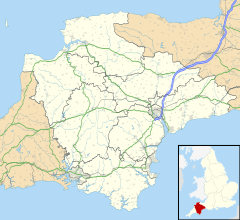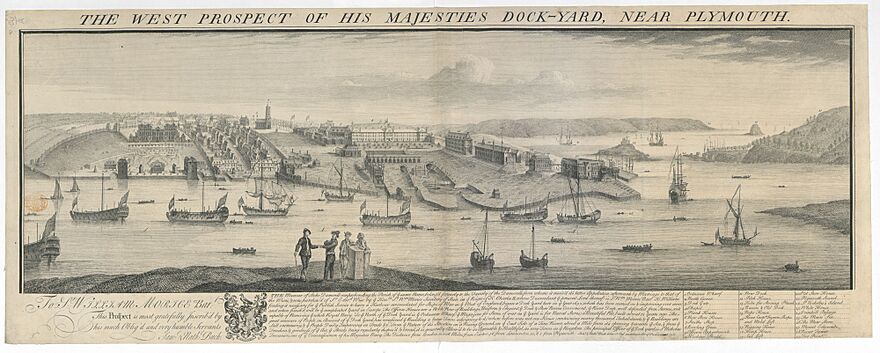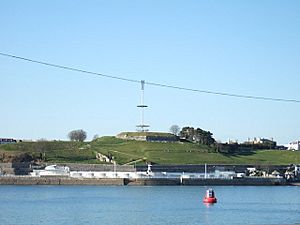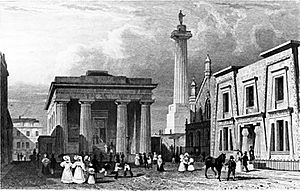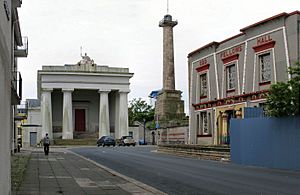Devonport, Plymouth facts for kids
Quick facts for kids Devonport |
|
|---|---|
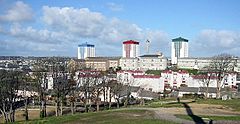 Devonport skyline |
|
| OS grid reference | SX455547 |
| Unitary authority | |
| Ceremonial county | |
| Region | |
| Country | England |
| Sovereign state | United Kingdom |
| Post town | PLYMOUTH |
| Postcode district | PL1 |
| Dialling code | 01752 |
| Police | Devon and Cornwall |
| Fire | Devon and Somerset |
| Ambulance | South Western |
| EU Parliament | South West England |
| UK Parliament |
|
Devonport is a part of Plymouth in Devon, England. It was once a very important town on its own. It even became a special type of town called a county borough in 1889.
Devonport was one of the "Three Towns" along with Plymouth and East Stonehouse. These three towns joined together in 1914. Later, in 1928, they officially became the City of Plymouth. Today, Devonport is part of the Plymouth Sutton and Devonport area for the UK Parliament. The person who represents this area in Parliament is Luke Pollard. In 2011, about 14,788 people lived in the Devonport area.
Contents
A Look Back in Time
How Devonport Started
In 1690, the British Navy decided to build a stone dock at a place called Point Froward. This spot was on the east side of the Hamoaze, which is where the River Tamar meets the sea.
Devonport was first known as Plymouth Dock. It began around 1700 as a small village. It was built to house the workers who were building the new naval base. By 1733, about 3,000 people lived there. By 1801, Plymouth Dock was even bigger than Plymouth and Stonehouse put together!
Renamed Devonport
By 1811, Plymouth Dock had over 30,000 people. The people living there felt that their town's name made it sound like it was just a small part of Plymouth. In 1823, they asked King George IV to change the town's name. They suggested "Devonport."
The King agreed, and the new name started on January 1, 1824. To celebrate, the town built the Devonport Column next to its new town hall, called the Devonport Guildhall. Both were designed by a famous architect named John Foulston. Devonport officially became a town with its own local government in 1837.
In 1914, Devonport joined with East Stonehouse to become part of Plymouth.
Protecting the Dockyard
In the mid-1700s, a large earth wall was built around the town and the dockyard to protect them. Inside these "dockyard lines," six square army barracks were built between 1758 and 1763. These barracks housed the soldiers who guarded the defenses.
Later, in the 1770s, more small forts called redoubts were built in front of the main walls. One of these, at Mount Pleasant, still has parts remaining today. In the early 1800s, the dockyard walls were made stronger with stone and cannons. The ditches around them were also made deeper.
These old defenses became less important when new, bigger forts were built around Plymouth in the late 1800s. Much of the open land outside the walls became Devonport Park in the 1850s.
Mount Wise: A Key Spot
The high ground south of Devonport is called Mount Wise. It was inside the town's main defenses and had its own fort in the 1770s. This fort had eight cannons and two mortars to protect the dockyard from the sea.
For a long time, Mount Wise was a very important place for the armed forces. The military Governor and the naval Commander-in-Chief of Plymouth both lived in large houses there. In 1805, a special factory was built at Mount Wise to make ammunition and explosives. This factory later became army barracks in the 1830s.
Devonport Today
In the 2000s, Devonport received a lot of money (about £48.7 million) from a government program called "New Deal for Communities." This money helped to make the area much better. Since 2009, these investments have really changed Devonport.
The area used to be run-down and had many problems. But now, Devonport is becoming a much nicer place to live. The city's goal is to make Devonport a "vibrant, self-sustaining community." It aims to be a place of "real quality, variety, and interest."
The Navy has also released some of its land in Devonport, which has helped with the rebuilding. For example, new homes were built on the old Admiralty House site at Mount Wise. Devonport is now becoming one of the most popular places to live in Plymouth.
In 2011, the Devonport Heritage Trail was created. It has over 70 markers that show interesting historical spots along the route.
What You Can Find Here
Devonport has its own shopping street, a train station, a swimming pool, a park, and a sports ground called The Brickfields. Since 2003, it has been home to Plymouth Albion, the city's Rugby union club. Their ground is near Plymouth City College.
Devonport also has the Devonport Playhouse. This is a theatre located in an old church building. A local theatre group bought it in 1987 and turned it into a performance space. It's a popular place for local acting groups, choirs, and dance schools.
UTC Plymouth is a special college that opened in September 2013 near Devonport Park. It is built on the site of a former community college.
The Torpoint Ferry service crosses the Hamoaze (part of the River Tamar) from Devonport to Cornwall.
The Devonport Naval base and Dockyard has a nickname among sailors: "Guz." One idea for this name is that it's short for "Guzzle," and it refers to the delicious Devon cream teas!
Famous People from Devonport
Many notable people were born or lived in Devonport:
- R. F. Scott (1868–1912) was a British naval officer and explorer. He was born in Devonport and led a famous expedition to the South Pole in 1910.
- N. T. Carrington (1777–1830) was a schoolmaster and poet.
- Charles Mathews was a theatre manager and funny actor who lived here for several months.
- Leslie Hore-Belisha, 1st Baron Hore-Belisha (1893–1957) was born in Devonport. He became a very important politician.
- Ralph Alger Bagnold (1896–1990) was born here. He was a pioneer in exploring deserts and founded the British Army's Long Range Desert Group. He also helped us understand how deserts are formed.
Charles Darwin, the famous scientist, spent two months in Devonport in 1831. He was waiting for the weather to get better so his ship, HMS Beagle, could start its journey to South America. The ship finally left on December 27. Darwin later wrote that those two months were "The most miserable which I ever spent."
Images for kids
More to Explore
 In Spanish: Devonport (Devon) para niños
In Spanish: Devonport (Devon) para niños


